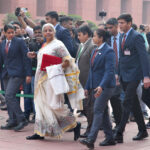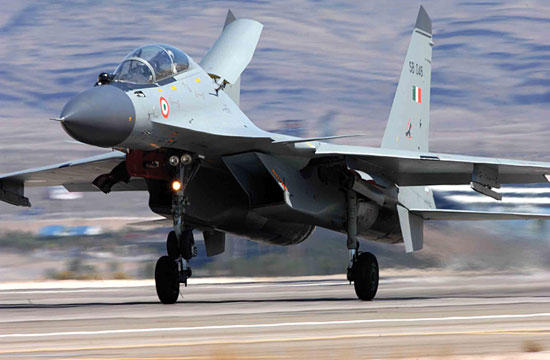INDIA is pressing ahead with the development of its stealth Advanced Medium Combat Aircraft (AMCA) despite facing a host of engineering and designing problems. Aeronautical Development Agency (ADA) director, CD Balaji, recently informed ‘Flight Global’ that the great majority of work for the shape of the AMCA has been completed. Yet, the first flight of the indigenous AMCA, according to Balaji, is planned for 2025. This reveals a significant departure from the ADA’s position in 2013 when the deadline for the first flight was scheduled for the end of the decade.
Obviously, the IAF can’t wait for that long as there are serious air power gaps between India and China. The IAF is already far below its sanctioned squadron strength of 42-45. Similarly, the Indian Navy (IN) is also in the desperate need for carrier-based AMCA aircraft.
While the biggest challenge facing the indigenous AMCA, both for the IAF and the IN, is the development of Radar Absorbent Material (RAM) to enhance the stealth configuration of the aircraft, the issue of selection of the engine, though unsettled as yet, is narrowed to General Electric F414, which powers the Boeing F/A-18 E/F Super Hornet, or the Eurojet EJ200, which powers the Eurofighter Typhoon. Clearly, the Kaveri engine developed by Gas Turbine Research Establishment Kaveri is out of the reckoning.
Balaji said that once the engine is selected, it may take three or four more years to develop the aircraft.
In view of the usual inordinate delay in executing the AMCA project, New Delhi has requested Dassault Aviation to advance the delivery schedule of Rafale fighter jets to overcome the air power deficit. But the French manufacturer has stated that it was not possible as the jets have to be customised according to Indian specifications.

“We are discussing the issue with the IAF. There is a schedule in the contract. It is difficult to speed up production of a new aircraft. If it is a matter of weeks, yes we can,” Eric Trappier, CEO of Dassault Aviation, told journalists at Bengaluru Aero India show. India ordered 36 jets last year from France and deliveries are scheduled between 2019 and 2022.
Defence Minister Manohar Parrikar had earlier said that they would request France to speed up deliveries further, if possible.
Trappier observed that 36 jets were a small number to enable greater technology transfer, pitching for more Rafales for India to gain access to better technologies under the Make in India drive. “India has ordered 36. It is a good number, but it is not good enough for competitive technology transfer. So, it will depend on the future,” he said. However, Parrikar had already restated that India did not intend to order any more Rafales. India-specific customisation was being currently undertaken, after which production would begin. Under the terms of the contract, Dassault will begin training Indian pilots and technicians in operating the jets next year. Dassault will also bid for the Navy’s tender for at least 57 carrier-based aircraft. Trappier said Rafale was the only aircraft which had both land-based and maritime variants.
 THE government’s reiteration of not buying more than 36 Rafales has encouraged US defense companies, Lockheed Martin and Boeing, to pitch in their offers. At the Aero India show, its representative said last month that talks were taking place between the US and the Indian government over its offer of setting up a factory to produce F-16 fighter planes in India.
THE government’s reiteration of not buying more than 36 Rafales has encouraged US defense companies, Lockheed Martin and Boeing, to pitch in their offers. At the Aero India show, its representative said last month that talks were taking place between the US and the Indian government over its offer of setting up a factory to produce F-16 fighter planes in India.
Lockheed is pushing ahead with its proposal to transfer the F-16 production line to India to supply the IAF, but it understands that US President Donald Trump’s administration may want to take a fresh look at such plans. “The conversation at this point has progressed between governments,” Randall L Howard, Lockheed’s head of F-16 business development, told reporters. “We have had very strong support up to this point from the US government. We are deferring any concerns over to the two governments as discussions have progressed to the point where requirements need to be more fully articulated,” Howard said, adding that Lockheed Martin is fully supportive of those discussions.
President Trump’s criticism of US auto and drug companies moving manufacturing overseas and then selling goods back to the US has raised concern over Lockheed’s plans, though in this case, the factory would supply the Indian military rather than export to the US.
After the conclusion of the Rafale deal, Defence Ministry issued a request last year, asking foreign manufacturers if they were willing to produce a single-engine combat plane in India in collaboration with a local partner as part of the government’s drive to build a domestic industrial base and reduce imports.
Sweden’s Saab is the other contender, offering to make its Gripen fighter in India. Media reports indicate that Boeing Company, which is trying to sell its F-18 fighter jets to the Indian Navy, is trying to work out a middle path that will satisfy the domestic manufacturing demands of both the US and India.
“We are willing to work with both Indian Navy and the US government to find a solution that works for everybody—that’s compelling when it comes to technological cooperation and industrial cooperation but that meets the objectives of both the governments,” Thom Breckenridge, vice-president, global sales, Boeing (India) told Mint.

The Indian Navy on January 25, 2017, put out a request for information (RFI) for 57 fighter planes to be submitted by May, and Boeing is pitching its F-18s. Boeing CEO Dennis Muilenburg has already held long meetings with Trump administration officials that were widely publicised. It is not clear if this matter was raised during those meetings. “I am not going to comment on company’s discussions with the administration. I would say the company is in dialogue with the US government and we look forward to continuing the conversation with them as and when this particular opportunity moves forward,” Breckenridge said. While the RFI does not specify requirements to manufacture F-18s in India, Boeing feels India will ask for it over time.
Under its planned strategic partnership model—recently proposed for the IAF order—India will select private local companies to exclusively manufacture military equipment for a specified period. The Indian partner will be identified through a model prescribed by a government committee, while the foreign partner will be chosen on criteria such as transfer of technology and the financial pitch.

PARRIKAR has made it clear that no relaxations will be granted. He told reporters on the sidelines of the 11th Aero India Show in Bengaluru last month: “What I am saying is what I want—I want it to be Made in India. Export to a third nation is an additional bonus (and) if someone wants to shift the facility from somewhere else or whether he sets up a new one—it is his choice. I am in no way concerned with it.”
To a question on whether the F-18 would be compatible with India’s aircraft carriers, some of them Russian, Boeing said it is working with the Indian Navy. “We need to continue to discuss with Navy to learn more about existing carriers, but based on what we know so far, based on the modelling we have done, we feel confident,” he said, adding, “We will definitely compete; we can’t say we will win or not, but I do think we have a very good case. It was designed for carrier-based operations. It is operating in US Navy as a frontline fighter. We have done 700 deliveries of F-18. It has scale, low costs to maintain and it has life ahead of it with continued investments out to 2040.”
Russia also is keenly watching India’s AMCA project. On the sidelines of Aero India, Russia and India agreed on a draft contract for the development of a joint Fifth Generation Fighter Aircraft (FGFA), FSMTC deputy head Drozhzhov said.
He stated: “Russian and Indian experts agreed and initialed the draft contract on the design work on the creation of prospective multifunctional fighter. The Russian side is ready to sign the contract. We expect the decision of our Indian partners on this issue.”
The FGFA is based on the Russian Sukhoi T-50 (PAK FA) fifth-generation stealth fighter aircraft. It is a single-seat, twin-engine multi-role jet fighter designed for air superiority and attack roles. The project came about following the signing of a Russian-Indian cooperation agreement on October 18, 2007.
According to Victor Kladov, Rostec State Corporation’s director for international cooperation who headed the delegation of 40 defense sector companies to the Bengaluru air show, Russia will also take part in the development of India’s fifth-generation AMCA project.
“We will certainly take part in this project. Once we see the terms of reference, we will determine the aircraft that will participate in the tender. We can offer the latest modernisation of the MiG-31, MiG-35, the brand new PAK FA and the modernised version of the Su-30MKI.”



























































